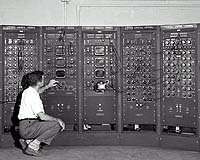 |
Washington DC (SPX) Nov 05, 2010 Taking the first steps of what would be a major historical advance in the science of measurement, the National Institute of Standards and Technology (NIST) is participating in a worldwide effort to recommend major revisions to the International System of Units (SI), the modern metric system that is the basis of global measurements in commerce, science and other aspects of everyday life. The new SI, which would be based on seven constants of nature, would enable researchers around the world to express the results of measurements at new levels of consistency and accuracy. The most significant change in the possible future revision of the SI would be in the kilogram, the only one of the SI's seven base units still defined in terms of a material "artifact": a 130-year-old platinum-iridium cylinder maintained at the International Bureau of Weights and Measures in France. The kilogram artifact poses long-term problems because its mass changes slightly over time. The proposed revision "puts the SI on a firm foundation," says Ambler Thompson, a NIST scientist involved in the international effort. "We get rid of the last artifact." In the current SI, it's not just the unit of mass that depends on the kilogram. The definitions of the ampere (electric current), mole (amount of substance) and candela (luminous intensity) ultimately depend on the platinum-iridium artifact. For example, a mole is currently defined as the number of carbon-12 atoms whose total mass is 12 grams. The new proposal defines the kilogram in terms of the Planck constant h, an important constant in quantum physics, which is expressed in units containing the kilogram. Efforts at NIST such as the watt balance experiment and determinations of the mass of one mole of silicon atoms offer new ways of determining an accurate value of h, thereby contributing to a more reliable definition of the kilogram. The new SI would specify agreed-upon values of the seven constants, according to the results of an analysis published by CODATA (Committee on Data for Science and Technology)of all of the relevant data. Fixed values of constants would then define all base units. For example, the ampere would be formally defined in terms of the electric charge of a proton, the kelvin (temperature) in terms of the Boltzmann constant, and the mole in terms of the Avogadro constant. However, before the revised SI could be implemented, additional experiments are needed to obtain more accurate values for some of the constants, especially the Planck, Avogadro, and Boltzmann constants. The Consultative Committee for Units, of which NIST is a member and which is one of 10 advisory committees of the International Committee for Weights and Measures (CIPM), submitted a draft resolution for a revised SI for consideration by the CIPM during its meeting in Paris, France, earlier this month. The CIPM, whose membership includes Willie May, director of NIST's Material Measurement Laboratory, approved the draft with only a few minor editorial changes on Oct. 15, 2010. The CIPM will soon submit the resolution for consideration at the General Conference on Weights and Measures (CGPM), the international diplomatic body that has the authority under the Meter Convention to adopt such a sweeping resolution during its October 2011 meeting. If the resolution passes and all the technical requirements are in place, a new SI could be in practice later in the decade. The seven SI base units from which all others are derived are the second (time), the meter (length), the kilogram (mass), the ampere (electric current), the kelvin (thermodynamic temperature), the mole (amount of substance) and the candela (luminous intensity).
Share This Article With Planet Earth
Related Links National Institute of Standards and Technology (NIST) Space Technology News - Applications and Research
 NASA Open Government Summit Emphasized Data Exchange
NASA Open Government Summit Emphasized Data ExchangeWashington DC (SPX) Oct 22, 2010 NASA is working to publish more of its data sets online and create more opportunities to engage with the public using digital tools. This was a major part of the discussion during the monthly Open Government Community Summit at NASA Headquarters in Washington last week. NASA's Office of the Chief Information Officer and Office of the Chief Financial Officer hosted the meeting. The event br ... read more |
|
| The content herein, unless otherwise known to be public domain, are Copyright 1995-2010 - SpaceDaily. AFP and UPI Wire Stories are copyright Agence France-Presse and United Press International. ESA Portal Reports are copyright European Space Agency. All NASA sourced material is public domain. Additional copyrights may apply in whole or part to other bona fide parties. Advertising does not imply endorsement,agreement or approval of any opinions, statements or information provided by SpaceDaily on any Web page published or hosted by SpaceDaily. Privacy Statement |